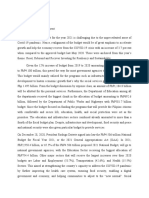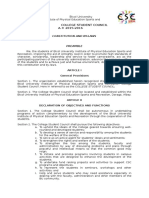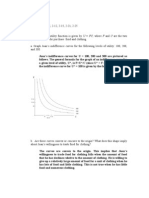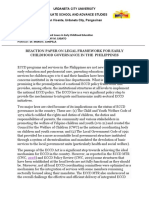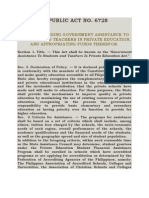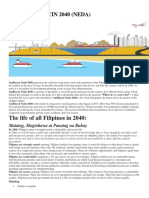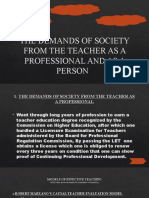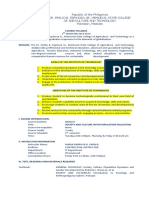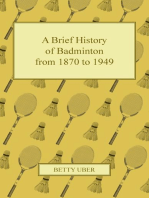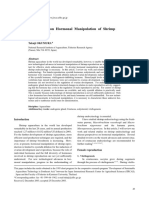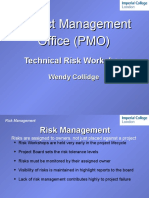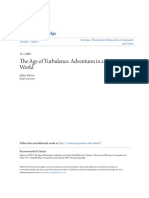Free Education in The Philippines: The Continuing Saga
Free Education in The Philippines: The Continuing Saga
Uploaded by
Yano skiCopyright:
Available Formats
Free Education in The Philippines: The Continuing Saga
Free Education in The Philippines: The Continuing Saga
Uploaded by
Yano skiOriginal Title
Copyright
Available Formats
Share this document
Did you find this document useful?
Is this content inappropriate?
Copyright:
Available Formats
Free Education in The Philippines: The Continuing Saga
Free Education in The Philippines: The Continuing Saga
Uploaded by
Yano skiCopyright:
Available Formats
International Journal of Advanced Engineering, Management and Science (IJAEMS) [Vol-5, Issue-4, Apr-2019]
https://dx.doi.org/10.22161/ijaems.5.4.2 ISSN: 2454-1311
Free Education in the Philippines: The
Continuing Saga
“A nation cannot be built without education.” (Taylor-Kamara, 2010)
Renato l. Virola
Nueva Ecija University of Science and Technology, Cabanatuan City, Philippines
renatovirola@gmail.com
Abstract— One of the most notable milestones in the Hence. August17, 2018 is another historic for the
Philippine education is when the government actively country when President Rodrigo RoaDuterte signed
seeks to expand access and participation in higher Republic Act 10931, to wit:
education through the ratification of RA 10931 or the “AN ACT PROMOTING UNIVERSAL ACCESS
“Universal Access to Quality Tertiary Education Act”. TO QUALITY TERTIARY EDUCATION BY
Thus, this study aims to examine and assess the effects of PROVIDING FOR FREE TUITION AN D
the law in our educational system. Providing sufficient OTHER SCHOOL FEES IN STATE
funds is not enough; the government must give meaning UNIVERS ITIES AND C OLLEGES, LOCAL
to the title of the new law, which is the provision of UNIVERS ITIES AND C OLLEGES AND STATE -
“quality” tertiary education. This program is an RUN TECHN ICAL-VOCATIONAL
investment in the nation’s most precious resource. INSTITUTIONS, ESTABLIS HIN G THE
Quality education empowers people and levels the TERTIARY EDUCATION SUBSIDY AN D
playing field; it is one of the best tools for poverty STUDENT LOAN PROGRAM,
alleviation, social equity and inclusive growth. There STRENGTHENIN G THE UNIFIED STUDEN T
should be no compromise on the quality of the services FINANCIAL ASSISTANCE SYSTEM FOR
provided under RA 10931. Free must not mean TERTIARY EDUCATION, AN D
substandard. In this study, the researcher used qualitative APPROPRIATING FUND THEREFOR”
research method. Qualitative research method was After nu merous debates, the Free Tu ition Fee
developed in the social sciences to enable researchers to Act of 2018 was finally signed into law. RA 10931’s
study social and cultural phenomena: observe feelings, landmark components include:
thoughts, behaviors and the belief of the mass society. 1. Free tuiti on for all required classes during
Keywords— Free Education, higher education, the semester. These classes must be part o f the
Universal Access to Quality Tertiary Education Act. curriculum and are essential in obtaining a
degree. Approved petitioned classes are covered,
I. INTRODUCTION too, but review or enhancement classes are not
A good education is one of the most important covered.
things an individual can pursue. There are many aspects The free tuition law also covers the fees of
of life that a comp lete education will affect a person. Filipino learners enrolled in any TESDA-
Having a high education mean ing a well-paying job, registered TVET program.
better opportunities, and a better life. It als o makes a 2. Free miscellaneous and other school
person smarter than someone without one. There are fees. The law covers payment for fees for the use
many ways in which education can benefit people. of lib raries, computers and laboratories, school
Free education is indeed important to many poor identification card, athletics, ad missions,
families. In the early years, most of our ancestors received development, guidance services, handbook,
no formal training at all because education during those entrance, registration, med ical and dental
times was only available to the upper class. Tutors and services, and cultural activities.
private academies only trained the few that could afford Should you wish to have another copy of your
an education, which increased the value of it. Education school identification card, library identification
played a major role in our history it was one of the majo r card, and student handbook, you will have to pay
issues that separated the wealthy from the poor. extra.
www.ijaems.com Page | 238
International Journal of Advanced Engineering, Management and Science (IJAEMS) [Vol-5, Issue-4, Apr-2019]
https://dx.doi.org/10.22161/ijaems.5.4.2 ISSN: 2454-1311
3. Affirmati ve acti on programs for II. STATEMENT OF THE PROBLEM
minorities. The law requires SUCs, LUCs, and Contrary to misperceptions, the new law has
TVET p rogram providers to craft programs to built-in mechanis ms that would encourage increased
make it easier for disadvantaged students to avail participation in the program fro m all socioeconomic
of the free tuit ion law. They may include classes, especially the poor. According to Rep. Joey S.
students who are Lu mad, Muslims, indigenous Salceda of the Second District of Albay, Republic Act
peoples, persons with disabilit ies, and students (RA) 10931 would now give poor students the drive to
from public high schools and depressed areas. strive further for self-development through free tertiary
4. Opt-out mechanism. Students with the and technical-vocational education, the high costs of
financial capacity can volunteer to opt out of the which had prev iously demoralized and fo rced them to
free h igher education provision. SUCs, LUCs, settle for low-paying jobs to survive.
and TVET providers are therefore required to The breakthrough legislation of Republic Act
create a system that would enable students to do 10931 is estimated to cost the government P10.486 billion
so. in tuit ion and P6 b illion in miscellaneous expense for
Students must decide to opt out of the subsidy 984,000 students in SUCs in 2018. Budget Secretary
during the enrollment period of each semes ter. Benjamin E. Diokno said that funding for the program
They will be required to submit a waiver duly will either be sourced fro m within the budget or requested
notarized by the institution. through supplemental budget, since the 2017
The decision is considered final and irrevocable appropriations have already been approved.
for that particu lar semester. Students are allowed RA10931 will have the effect of further
to change their decision in the next semesters. constraining, if not totally eradicating, whatever lat itude
5. Student vol untary contri bution administrators of State and local colleges and universities
mechanism. The law also allows financially - have. With full subsidies not only on tuition but even on
able students to avail of the free h igher education specific expenses such as ID and dental and medical fees,
provision but also contribute a specific amount and even computer and lab fees, all of the budget needed
to the higher education institution (HEI). SUCs, for operations, and not only personnel services, will be
LUCs, and TVET providers are required to downloaded from the DBM . So me Presidents of SUCs
create a proper system so students can make have expressed their misgivings about the serious
voluntary contributions for their education. consequences of this system, for it will surely tie their
6. Tertiary Educati on Subsidy (TES ). Students hands even more.
and learners may apply to get subsidies to help Has the government considered the fact that no
pay for tuition and fees in private institutions. developing country has ever attempted to make public
Under TES, they may also apply for subs idies to tertiary education totally free, not even in the most
get allowances for books, supplies, developed United States of America.
transportation, room and board costs, and other The huge amount of investment for the
expenses. A student with disability will also be implementation of the universal access to quality tertiary
given a separate set of allo wance. Students education raises several questions.Can the Philippine
whose programs require a professional license or Govern ment sustain the funding for the said program? Is
certification will also be given money to fund there an expected output as return of investment from the
their application for the first time. said program? Will RA 10931 certain ly benefit each and
Students and learners, however, must first every young Filipino who wanted to finish college fo r the
qualify under the existing admission and betterment of their living?
retention requirements or other screening and The economic managers raised valid points our
assessment procedures required by the program. lawmakers need to consider before the legislation is
7. Student Loan Program for Tertiary passed. This issue definitely deserves thorough study
Education. The free tuition law IRR also allows since the nation’s budget is not that huge and we
enrolled students to avail of an education loan. definitely need to be prudent about our spending
The UniFAST Board shall imp lement the loan priorities. Education is very important, more reason the
program through partner banks or similar limited money should go to those who need it most.
institutions.
III. RESEARCH METHODOLOGY
Generally, research design means a structure to
plan and execute a particular research. Research design is
www.ijaems.com Page | 239
International Journal of Advanced Engineering, Management and Science (IJAEMS) [Vol-5, Issue-4, Apr-2019]
https://dx.doi.org/10.22161/ijaems.5.4.2 ISSN: 2454-1311
the crucial part of the research as it includes all the four In this research let’s take a look at at the three
important considerations: the strategy, the conceptual (3) state-run academies here in the Ph ilippines, namely :
framework, the identification of whom and what to study Philippine Military Academy, Philippine National Police
on and the tools and procedures to be used for collecting Academy, and Philipp ine Merchant Marine Academy.
and analyzing data. Cadets – as they called their students, in these institutions
The research design basically is div ided into enjoy government subsidies for their t rain ing and
several types for examp le qualitative research and education. Subsidies provided are not limited to school
quantitative research. tuition fees and miscellaneous fees. Perks may include
In this study, the researcher used qualitative uniforms, board & lodging facilit ies, food, and/or regular
research method. Qualitative research method was monetary allowances for each cadet. Sounds like a heavy
developed in the social sciences to enable researchers to investment, right? Ho wever, each of these academies has
study social and cultural phenomena: observe feelings, their own program that can distinctively quantify return of
thoughts, behaviors and the belief of the mass society. investments for the government. These programs are
Examples o f qualitative methods are action research, case clearly defined on each of their mandates, as defined by
study research and grounded theory. Qualitative data specific Republic Acts that govern the operations of these
sources include observation and participation observation academies.
(field work), interv iews and questionnaires, documents The National Defense Act of 1935 provides for
and texts, and the researcher’s impressions and reactions . the Mandate of the Philippine M ilitary Academy. This
Research methodology is basically a process of Baguio-based institution is tasked to train and educate
how a research is being conducted. It enco mpasses tools selected candidates for permanent commission in the
and techniques to conduct a particular research or finding. regular workforce of the Armed Forces of the Philippines.
Research method is a range of tools that are used fo r The full subsidies mentioned above are provided to each
different types of enquiry. Therefore, it is important to cadet during their four (4) years of engagement in the
select an accurate method that suits the research objective. Academy. After obtaining their baccalaureate degree, its
In this section, the researcher will break the co mponents graduates are obliged to serve the Armed Forces of
into two: data collection method and also data analysis Philippines. They may be assigned to either of these three
method. (3) branches of the Armed Forces of the Philippines:
Data Co llect ion Method The researcher applied military, navy, or air force, where they are mandated to
two methods of data collect ion techniques. This was done serve 20 years, which includes their period of stay in the
in order to collect adequate and relevant data to address academy.
the research objectives of this study. Nonetheless, the The Philippine National Police Academy has a
researcher used qualitative research method. very similar set-up. The graduates’ choices of service
Library Research is a p rocess of dealing with the include engagement in the police force (Ph ilippine
analysis of evidences such as historical records and National Po lice), jail management (Bureau of Jail
documents. Similarly, it means gathering data fro m Management and Penology), or fire fighters (Bureau o f
lib rary materials which includes textbooks, both Fire Protection).
published and unpublished academic documents such as On the other hand, graduates of the Philippine
journals, conference proceedings, dissertations and theses. Merchant Marine Academy have both options to opt for
Library research also includes informat ion gathered fro m government service or commercial engagement. Both of
internet search. which have quantifiab le return of investments that
benefits our country. Go ing for government service may
IV. THEORETICAL/ CONCEPTUAL be either for the Philippine Navy or Ph ilippine
FRAMEWORK Coastguard. Pursuing a career with co mmercial
As described, the theoretical and conceptual engagement, where they engage as officers or engineers
framework exp lains the path of a research and grounds it of merchant marine vessels (both local and international
firmly in theoretical constructs. The overall aim of the shipping) gives them opportunities to contribute indirectly
two frameworks is to make research findings more to national treasury through their dollar remittances,
mean ingful, acceptable to the theoretical constructs in the which helps to stabilize peso and dollar exchange rates as
research field and ensures generalizab ility. They assist in well.
stimulat ing research while ensuring the extension of In view of the examp les mentioned above, we
knowledge by provid ing both direction and impetus to the can at least quantify that contributions of the graduates
research inquiry. They also enhance the empiricis m and fro m the institutions mentioned have a direct or indirect
rigor of a research. return of investment to the government that provided
www.ijaems.com Page | 240
International Journal of Advanced Engineering, Management and Science (IJAEMS) [Vol-5, Issue-4, Apr-2019]
https://dx.doi.org/10.22161/ijaems.5.4.2 ISSN: 2454-1311
them subsidies, so they may comp lete their education of education, commonly referred to as the deed in the
program and train ing. However, we are aware that most country. The Department of Education controls the
of the State Universities and Colleges and Local Philippines education system, including the curricu lu m
Universities and Colleges do not implement the same used in schools and the allocation of funds. It also
mechanis m. And as we all know as well; the Philippines regulates the construction of schools and other
is one of the major suppliers of manpower all over the educational facilities and the recruit ment of teachers and
world. The percentage of brain drain, and brawn drain staff.
based on the availab le labor statics is quite high. It only By law, education is co mpulsory for thirteen
means that talents, skills, and expertise of most of our years (kindergarten and grades 1–12). These are grouped
countrymen are being enjoyed by other countries more into three levels: elementary school (kindergarten–grade
than our country enjoys it. Of course, it is part of people’s 6), junior high school (grades 7–10), and senior high
democratic liberty to choose what and where they would school (grades 11– 12); they may also be grouped into
like to work, especially if all education and training four key stages: 1st key stage (kindergarten–grade 3), 2nd
supports were shouldered by themselves. However, if the key stage (grades 4–6), 3rd key stage (grades 7–10) and
same arrangement would be applied for products of the 4th key stage (grades 11–12). Children enter kindergarten
free education law, it would seem that the Philippine at age 5. For the academic year 2017–2018, about 83% o f
government has invested for the future workforce o f other K–12 students attended public schools and about 17%
countries. If I am working in a human resource either attended private schools or were home-schooled.
department of a company, I would not engage our According to Wikipedia - State universities and
company staff on any education or training program if I colleges (SUCs) refers to any public institution of higher
am aware that other companies (specially my learning that was created by an Act passed by the
competitors) wou ld be the one benefited with the Congress of the Philippines . These institutions are fully
additional knowledge and skills that my staff have subsidized by the national government, and may be
acquired. It is quite illogical to invest on someone that has considered as a corporate body.SUCs are fully funded by
a high probability to leave your organizat ion, in this case the national government as determined by the Ph ilippine
our country, thus, free education wou ld not be that Congress. The University of the Philippines System,
beneficial in the long run. being the "national university”,receives the biggest chunk
Filipinos believe that education is the key to of the budget among the 456 SUCs, and has likewise been
success. It is the key to imp rove the quality of our lives. strengthened by law through Republic Act 9500. SUCs
Fro m grade school to secondary to college. We all know are confronted by annual budget cutbacks. As a result,
that education can help us to achieve our goals in life. these schools impose enrolment quotas and increase fees.
Education is also responsible in provid ing competent In recent years, tuition and miscellaneous fees in the
human resources that will be able to carry out day -to-day SUCs have seen huge increases.
tasks according to the standards that is set by the society. You may attend technical schools, vocational
However, due to financial d ifficu lty we tend to set aside schools or higher education institutions such as
the education and work at the very young age. So me of us Universities. At the age of 16, if you did well enough
won’t be able to fin ish school but some have a degree. during your High School education, you can start working
Most Filip inos are clever and talented. We can co mpete to at a higher education, vocational or technical school, but
other nationality easily. you must be accepted for it first. Courses last between one
Across the years our educational system has year and up to as many as seven years. PH education gets
been rocked by controversies which have remained the biggest chunk of the national budget. The 2018 budget
unabated up to this day. Amidst the welter of issues, two allocation for govern ment agencies handling education
of them have managed to stand out in importance: quality amounts to P672.41 billion. Th is year's budget is a P10 -
and relevance. The major d ifficu lty in education in the billion increase from 2017's P543.2 billion.
Philippines is the short-sighted policy of sacrificing the President Duterte signed RA 10931 in August
quality and quantity of education for reasons of economy. 2017, while its implementing rules and regulations (IRR)
The quality of education at public schools remains poor. were launched in March 2018.
Classes are big, teaching material is lacking and teachers The law covers the tuition and fees of students
are poorly paid. enrolled in 112 state universities and colleges (SUCs), 87
Most local Filip ino children attend public accredited local universit ies and colleges (LUCs), and all
schools, which are funded by the government and free to technical-vocation education and training (TVET)
attend from grade school to college. Education in the programs registered under the Technical Education and
Philippines is managed and regulated by the department Skills Development Authority (Tesda).
www.ijaems.com Page | 241
International Journal of Advanced Engineering, Management and Science (IJAEMS) [Vol-5, Issue-4, Apr-2019]
https://dx.doi.org/10.22161/ijaems.5.4.2 ISSN: 2454-1311
Table 4.1 as shown below are the state-funded wide colleges and universities system, and specialized
schools, colleges and universities in the Ph ilippines. The schools. This list does NOT include locally funded
list includes national colleges and universities system, schools, colleges and universities.
region-wide colleges and universities system, province-
Table 4.1
Name Region
Abra State Institute of Science and Technology Cordillera AdministrativeRegion
Adiong Memorial Polytechnic State College ARMM Region
Agusan del Sur State College of Agriculture and Technology Caraga
Aklan State University Western Visayas
Apayao State College Cordillera AdministrativeRegion
Aurora State College of Technology Central Luzon
Basilan State College ARMM Region
Bataan Peninsula State University Central Luzon
Batanes State College Cagayan Valley
Batangas State University CALABARZON
Benguet State University Cordillera AdministrativeRegion
Bicol State College of Applied Sciences and Technology Bicol Region
Bicol University Bicol Region
Bohol Island State University Central Visayas
Bukidnon State University Northern Mindanao
Bulacan Agricultural State College Central Luzon
Bulacan State University Central Luzon
Cagayan State University Cagayan Valley
CamarinesNorte State College Bicol Region
Camarines Sur Polytechnic Colleges Bicol Region
Camiguin Polytechnic State College Northern Mindanao
Capiz State University Western Visayas
Caraga State University Caraga
Carlos Hilado Memorial StateCollege Western Visayas
Catanduanes State University Bicol Region
Cavite State University CALABARZON
Cebu Normal University Central Visayas
Cebu Technological University Central Visayas
Central Bicol State University of Agriculture Bicol Region
Central Luzon State University Central Luzon
www.ijaems.com Page | 242
International Journal of Advanced Engineering, Management and Science (IJAEMS) [Vol-5, Issue-4, Apr-2019]
https://dx.doi.org/10.22161/ijaems.5.4.2 ISSN: 2454-1311
Central Mindanao University Northern Mindanao
Central Philippines State University Western Visayas
Compostela Valley State College Davao Region
Cotabato Foundation College of Science and Technology SOCCSKSARGEN
Cotabato State University SOCCSKSARGEN
Davao del Norte State College Davao Region
Davao Oriental State University Davao Region
Don Honorio Ventura Technological State University Central Luzon
Don Mariano Marcos Memorial State University Ilocos Region
Dr. Emilio B. Espinosa Sr. Memorial State College of
Bicol Region
Agriculture and Technology
Eastern Samar State University Eastern Visayas
Eastern Visayas State University Eastern Visayas
Eulogio "Amang" Rodriguez Institute of Science and
NCR and Cavite
Technology
Guimaras State College Western Visayas
Ifugao State University Cordillera AdministrativeRegion
Ilocos Sur Polytechnic State College Ilocos Region
Iloilo Science and Technology University Western Visayas
Iloilo State College of Fisheries Western Visayas
Isabela State University Cagayan Valley
J.H. Cerilles State College Zamboanga Peninsula
Jose Rizal Memorial State University Zamboanga Peninsula
Kalinga State University Cordillera AdministrativeRegion
Laguna State Polytechnic University CALABARZON
Leyte Normal University Eastern Visayas
Mariano Marcos State University Ilocos Region
Marikina Polytechnic College NCR
Marinduque StateCollege MIMAROPA
Mindanao State University ARMM Region and other locations
Mindanao State University - Buug College Zamboanga Peninsula
Mindanao State University – Iligan Institute of Technology Northern Mindanao
Mindanao State University – Tawi-Tawi College of
ARMM Region
Technology and Oceanography
Mindoro State College of Agriculture and Technology MIMAROPA
Mountain Province State Polytechnic College Cordillera AdministrativeRegion
www.ijaems.com Page | 243
International Journal of Advanced Engineering, Management and Science (IJAEMS) [Vol-5, Issue-4, Apr-2019]
https://dx.doi.org/10.22161/ijaems.5.4.2 ISSN: 2454-1311
Naval State University Eastern Visayas
Negros Oriental State University Central Visayas
North Luzon Philippines State College Ilocos Region
Northern Iloilo Polytechnic State College Western Visayas
Northern Negros State College of Science and Technology Western Visayas
Northwest Samar State University Eastern Visayas
Northwestern Mindanao State College of Science and
Northern Mindanao
Technology
Nueva EcijaUniversity of Science and Technology Central Luzon
Nueva Vizcaya StateUniversity Cagayan Valley
Occidental Mindoro State College MIMAROPA
Palawan State University MIMAROPA
Palompon Polytechnic State University Eastern Visayas
Pampanga State Agricultural University Central Luzon
Pangasinan State University Ilocos Region
Partido State University Bicol Region
Philippine Merchant Marine Academy Central Luzon
Philippine Military Academy Cordillera AdministrativeRegion
Philippine Normal University NCR and other locations
Philippine State College of Aeronautics NCR and other locations
Polytechnic University of the Philippines NCR and other locations
President Ramon Magsaysay State University Central Luzon
Quirino State University Cagayan Valley
Rizal Technological University NCR
Romblon State University MIMAROPA
Samar State University Eastern Visayas
Siquijor State College Central Visayas
Sorsogon State College Bicol Region
Southern Leyte State University Eastern Visayas
Southern Luzon State University CALABARZON
Southern Philippines Agri-Business and Marine and Aquatic
Davao Region
School of Technology
Sultan Kudarat State University SOCCSKSARGEN
Sulu State College ARMM Region
Surigao del Sur State University Caraga
Surigao State College of Technology Caraga
www.ijaems.com Page | 244
International Journal of Advanced Engineering, Management and Science (IJAEMS) [Vol-5, Issue-4, Apr-2019]
https://dx.doi.org/10.22161/ijaems.5.4.2 ISSN: 2454-1311
Tarlac Agricultural University Central Luzon
Tarlac State University Central Luzon
Tawi-Tawi Regional Agricultural College ARMM Region
Technological University of the Philippines NCR and other locations
University of Antique Western Visayas
University of Eastern Philippines Eastern Visayas
University of Northern Philippines Ilocos Region
University of Rizal System CALABARZON
University of Science and Technology of Southern
Northern Mindanao
Philippines
University of Southeastern Philippines Davao Region
University of Southern Mindanao SOCCSKSARGEN
University of the Philippines NCR and other locations
Visayas State University Eastern Visayas
West Visayas State University Western Visayas
Western Mindanao State University Zamboanga Peninsula
Western Philippines University MIMAROPA
Zamboanga City State Polytechnic College Zamboanga Peninsula
Zamboanga State College of Marine Sciences Zamboanga Peninsula
Since they're already benefiting fro m the receive salaries all wh ile lodging and eating for free
government, why do students from state-run universities inside the academy's barracks. State university students,
still go against the state? mean while, have differing levels of grants, with so me
They are the hope of our nation, those especially being forced to take part-time jobs to make do and
studying in state universities who need to maintain an graduate.
average grade. These are considered as the cream of the I truly believe that the education is the only way
crop already. If they are the cream of the crop, they our country Philipp ines will prosper if children are getting
should be the hope of the land. a good education. This is the only way things will bring a
These youth are given education no less than the change for the better to our lives and the better of our
government. In state universities, you are given free Philippine society today. The shortages of classrooms and
education by the government and yet they have not textbooks are particularly severe. The fact that teachers
graduated and they are already going against the are paid subsistence wages is only half of their sad story.
government that gives them free education. Their daily bout with dilap idated classrooms,
If the students have to learn something, if they overcrowded classes, and lack of teaching materials,
have questions or doubts, maybe we can shed light on among others, make the teachers hardly rewarded work
what a student should learn. Maybe this is also to develop even more difficult.
our sense of nationalism and love of country. Co mparing In lieu of paying the tuition fees of
it to PMA scholars, where back then they were required to undergraduate students in state universities and colleges
work fo r the govern ment after their graduation. All cadets (SUCs), Socioeconomic Planning Secretary Ernesto M.
get free tuit ion and even receive salaries all while lodging Pernia, Finance Secretary Carlos G. Do minguez III and
and eating for free inside the academy's barracks. State Budget Secretary Benjamin E. Diokno recommended the
university students, meanwhile, have differing levels of full funding of the Unified Student Financial Assistance
grants, with some being forced to take part-time jobs to System fo r Tertiary Education (UniFAST). They said it is
make do and graduate. All cadets get free tuition and even a “better alternative because it provides a mo re coherent
www.ijaems.com Page | 245
International Journal of Advanced Engineering, Management and Science (IJAEMS) [Vol-5, Issue-4, Apr-2019]
https://dx.doi.org/10.22161/ijaems.5.4.2 ISSN: 2454-1311
and comprehensive framework to address the educational Looking at the bright side, it would be a big help
needs of the students and is better designed to ensure a to our beloved parents. Huge amount of money will be
more efficient and effective use of government funds”. kept. That money can be used for other household
The economic experts cited several reasons, first purposes.
of wh ich is the fact that only 12 percent of the students in It is likewise indicated that students from poorer
SUCs belong to the bottom 20 percent of the family - households had a lo wer chance of getting into SUC’s
income classificat ion. This means that government because of co mpetition and limited slots. To the extent
funding will largely be spent paying for tuition of that government surveys typically fail to capture
students who may be able to afford to pay, anyway. responses from the richest households, the degree of
Another reason given was that tuition constitutes education inequality may actually be larger.
only one-third of the annual cost of attending college. Students has a limited option to choose what
Other expenses include liv ing e xpenses and instructional course they would like to take advantage with. There
materials. That said, the poor families would still be were only limited number of students allowed per
unable to send their children to college even if tuition classrooms. So me students were in doubt because of
were free, because it would still be difficu lt to raise the return of service although it’s the only way to help the
bigger chunk of money (two-thirds) needed to pay for a university clean.
full college education. If financial access were the only problem, then
Apart from these important issues, the economic free tuit ion may help the poor access SUCs more. But this
managers are concerned about the possible exodus of is not the case. Public colleges, unlike public elementary
students from private higher educational institutions and high schools, almost always screen students using
toward the SUCs. This would have an effect on the other criteria (e.g., admission tests and high school
quality of graduates and also affect the government’s grades). Hence, perhaps a more important policy issue to
budget.“The budgetary support for free tuition will be address is why the richest students can better access
difficult to sustain,” they said in their position paper. The SUCs in the first place, and why they edge out their
SUCs wou ld require about P28 billion fro m the poorer counterparts. If we don’t help poor but bright
government to cover the tuition of the 1.4 million students students hurdle other aspects of “accessibility”, then free
currently enrolled. If the enrolments increase in the tuitions will do little to help them. In fact, the benefits
coming years, this amount would still balloon fro m free tuit ions will only accrue more to the rich than
substantially. the poor.
The UniFAST was established in 2014 through
Republic Act 10687. Its task is to unify and harmon ize all V. FINDINGS
modalities of publicly funded Student Financial Reports said that as of November 9, only 9 out of
Assistance Programs (StuFAPs), like scholarships, grants - 199 public higher education institutions (HEIs) –112
in-aid and student loans for tertiary education. The SUCs and 87 LUCs – have been given funds to
economic experts see it as a wiser, more prudent move to implement the free tuition law during the first semester,
support UniFAST instead so it could do its job efficiently. while none has been paid for the second semester.
They all agree that “the Un iFAST is better designed to .In order to guarantee success and to feel
ensure a more efficient and effective use of government secured, Philippine government must invest time and
funds”. money to education. The government has a responsibility
The economic managers raised valid points our to support and fund the programs required to be done to
lawmakers need to consider before the legislation is ensure a quality education for every student.
passed. This issue definitely deserves thorough study The economic achievement is based on
since the nation’s budget is not that huge and we education. I believe that education is the heart of a
definitely need to be prudent about our spending nation’s success and an aggressive willingness to
priorities. Education is very important, more reason the compete. And that is a fact, no onecan argue with that
limited money should go to those who need it most. contention.
I don’t really see our country will overcome its College is expensive, and the process of
crisis in the next 10 to 20 years. Our country Philippines applying for and receiving financial is co mp licated and
has fallen behind in in key areas of education. I hope stressful. Many families do not realize that they will
everyone can agrees why our education today is wrong on likely pay only a fraction of the sticker price of co llege. I
so many levels, so together we can work jointly and help support the goal of free college. More than ever, a college
our students and our country succeed. degree is a t icket to the middle class. The question is how
www.ijaems.com Page | 246
International Journal of Advanced Engineering, Management and Science (IJAEMS) [Vol-5, Issue-4, Apr-2019]
https://dx.doi.org/10.22161/ijaems.5.4.2 ISSN: 2454-1311
to get there. Co llege is a financial burden for nearly every Such disadvantages are magnified by the
family. relatively poor quality of public education, which has
The majority of young people who agreed that dragged the nation’s overall educational quality. Although
higher education should be funded by the government and strides have been made in the past decade, the quality of
that students should not have to contribute towards the math and science education in the Philippines still ranks
costs of higher education. The main justification for the among the worst in the region.
young people’s support of free tu ition was in terms of the Of course, some public schools are of top-notch
perceived benefits of widening access. It was felt that the quality (e.g., science high schools). But today it is not
policy helps to encourage more young people to go to uncommon to find some very rich families sending their
university, particularly those young people fro m mo re kids to these public schools to boost their chances of
disadvantaged backgrounds . admission in the top universities. Even at this level, rich
Young people were proud of this system, not just students “crowd out” or co mpete away slots fro m poor
because, as they noted, they were able to benefit fro m it, but bright students.
but because it gave people across the Philippines ‘equal The inequality extends to college admission
opportunity’ to go to university. Higher education was preparations: rich parents are usually more aware o f
seen as improving people’s life chances and as a means of college ad mission processes (forms, fees, schedules) and
helping them to become mo re socially mob ile. That this is also enroll their children in specialized review classes
a universal benefit which treats everyone equally where they can take simulated college entrance exams.
regardless of their background was considered its most In contrast, poor parents in some cases may even
important aspect, and interviewees variously described it be unaware of such admission processes and lack
as ‘fair’, ‘equal’ and ‘open’. Means testing, or charging resources to enroll their children in review classes.
students from more affluent backgrounds, was seen as Without these, poor parents are less able to prepare their
being too complicated to admin ister by most. So me children for college the way rich parents can.
students from other schools were of the opinion that it We need to address more strongly these
would be ‘unfair’ to charge pupils from richer families. disparities between the early lives of rich and poor
A frequently expressed argument for universal students. Otherwise, we should not be surprised that rich
free tuition was that it was deemed ‘ fair’. However, students are the ones in SUCs, not poor students.
students held different understandings of what fairness Some p rograms already aim to bridge such
meant. Those in favour of free tuition tended to describe inequalities of opportunity. For instance, this is precisely
‘fairness’ as everyone treated equally. In contrast, the rationale behind PantawidPamilya, which incentivizes
students in favour of targeted contributions tended to hold very poor parents to send their children to school, with
a view more allied to ideas of social justice and the end goal of breaking the transmission of poverty
redistribution. So me young people, suggested that it across generations.
would be ‘fairer’ if those from richer backgrounds were The K to 12 program is yet another intervention
asked to contribute towards free higher education for the in basic education, albeit with a slightly different
poorest. objective: to expand job opportunities and reduce the
The truth is, the poorest students today are edged “education-skills mismatch” in the country. However, K
out in SUCs due to many disadvantages they face in their to 12 still suffers fro m large shortfalls of teachers and
early years. Rich students usually find themselves being facilit ies, and it will take longer for the program to help
propelled through their education with the full, undivided students better prepare for college or otherwise.
support of their family, relatives, and co mmunity. They
are likelier to be enrolled in exclusive schools with top VI. CONCLUSION
facilit ies; likelier to be exposed to numerous In conclusion, the evidence from th is research
extracurricular and sports; and likelier to be paired with suggests that young people are becoming increasingly
tutors whenever they encounter difficulties in school. focused on the labour market opportunities that a degree
In contrast, poor students usually find can provide. A number of students, felt that tuition fees
themselves in more challenging situations. They are might eventually deter people fro m poorer backgrounds to
likelier to be enrolled in public schools with more attend university. Research suggests that this is an
crowded classrooms and subpar facilit ies; likelier to take unrealistic intention. Young people also differed in their
on odd jobs to help in family finances; and likelier to attitudes and this had led some to question the value of
study by themselves without the benefit of expensive going to university. The level of understanding of
tutors. students were generally poor and worse among the
www.ijaems.com Page | 247
International Journal of Advanced Engineering, Management and Science (IJAEMS) [Vol-5, Issue-4, Apr-2019]
https://dx.doi.org/10.22161/ijaems.5.4.2 ISSN: 2454-1311
younger students, and is an area which may require opportunities and led some to question the value of higher
further consideration from relevant bodies in the future. education.
The biggest challenge facing the country’s It would be fair to say that indeed the Duterte
education system is how to improve access to affordable administration has nothing but good intentions only upon
quality education so that the country can maximize its enacting into law the RA 10931. Ho wever, the
demographic div idend. So me students tend to take government should have been more prepared in doing so.
education for granted although it’s already free. Their Bear in mind that it is not just a matter of giv ing away
parents are glad though. I was hoping that students will free education but moreover making education accessible
take education seriously. Free tuit ion is really a big help to everyone.
to us. We know that this is the largest fund that The funding concern, however, cannot be
government had to released. Being able to attend to class ignored. Economic managers have stressed that the war in
on a daily basis is so so. In terms of quality education Marawi and other expenditures in national defense and
some might be able to exceed the quality but some might law enforcement have been a significant drain on public
not. funds. The government is also providing free kindergarten
Recently, the Philippine Institute for and two more years of basic education under the K to 12
Develop ment Studies (PIDS) illustrated the disadvantages program. Both Malacañang and Congress must make sure
of free tuit ion through infographics. It was based on a there will be enough funds to support the free tertiary
policy paper, “Who benefits and loses fro m an untargeted education program.
tuition subsidy for students in SUCs (state universities Without any major reforms in the admissions
and colleges)?” requirements for entry into public universities and
Giv ing financial assistance is anti-poor because colleges, and with matching support to upgrade the
tuition comprises only one third of college education quality of basic education, I am afraid that this law will
costs. Most students from SUCs were not poor; in fact, never provide universal access to quality tertiary
rich households are the ones most likely to benefit fro m a education.
free tuit ion law. Free tuit ion will benefit the rich, but In the first place, the very presence of
freeing educational expenses, such as tuition, gives competitive entrance exams is already evidence that
monu mental relief to the poor. Why not distribute the access is not universal.
subsidy of free education to other educational And if the system would operate like a free
institutions? Assuming they are well-managed, the poor market, then those who have higher levels of
will be more qualified for SUCs. competitiveness, like students who graduate from quality
Whether or not free tuition becomes a long-term high schools, or thos e from families who can afford
investment for SUCs, much needs to be done about the review classes, would have the upper hand. There is a big
government’s budget, as well as the implementation of probability that this will crowd out those who are in fact
educational policies. in need of state support, the poor and who are g raduates
That Philippine’s education system is not a bad of less competitive schools.
one. It has plenty of opportunity for students to get an The story of Philippine Education does not end
education. The sequence of events is the same fo r all in the singing of RA 10931 and the saga continues as the
students and is mandated by law. The law also dictates government tries better its implementation.
how many days and years a child spends in school, with it
currently being 12 years with 200 days per year in school. VII. RECOMMENDATION
Students raised the issue as to whether a young It wou ld have also been more efficient and could
person ‘deserves’ to have their higher education paid fo r push higher education institutions (HEIs) to enhance their
by the government. The idea that young people should quality had financial assistance been given directly to
work hard and not take their learn ing for g ranted was students, as this will spur HEIs to be more co mpetitive fo r
espoused. They worried that where higher ed ucation them to attract students on full scholarships.
tuition is free this would encourage students to study ‘for But for now, it would be prudent to impose a
the sake of it’, wh ich might possibly lead them to ‘waste’ moratoriu m on the establishment of SUCs and their local
government funding. This was seen as particularly likely counterparts, and to devise innovative mechanisms to
where young people studied subjects which did not ensure that the quality education which is pro mised by the
necessarily lead to a particular career. The intrinsic value law is delivered. It is also imperative to come up with an
of learn ing came secondary to the discourse of IRR that will mitigate the law’s adverse effects.
emp loyability. Fears about graduate emp loyment
www.ijaems.com Page | 248
International Journal of Advanced Engineering, Management and Science (IJAEMS) [Vol-5, Issue-4, Apr-2019]
https://dx.doi.org/10.22161/ijaems.5.4.2 ISSN: 2454-1311
REFERENCES
[1] Republic Act 10931 – “Un iversal Access To Quality
Tertiary Education Act”
[2] Republic Act 10687 – “Unified Student Financial
Assistance System for Tertiary Education
(UniFAST) Act”
[3] Joint Memorandum Circular No. 2017-1 20 April
2017, Depart ment of Budget & Management and
Commission on Higher Education
[4] “Educational Po licy Innovations” by Sin Kong Lee,
Wing On Lee and Ee Lin Low
[5] “Why Public Higher Education Should Be Free” by
Robert Samuels
[6] https://en.wikipedia.org/wiki/Higher_education_in_t
he_PhilippinesState_universities_and_colleges
[7] https://en.wikipedia.org/wiki/ List_of_state_schools,
_colleges_and_universities_in_the_Philippines
www.ijaems.com Page | 249
You might also like
- Sociology of Education in Philippine SettingDocument21 pagesSociology of Education in Philippine SettingJanice SenseiNo ratings yet
- Case Analysis: The Current State and Issues Regarding The Free Tuition LawDocument50 pagesCase Analysis: The Current State and Issues Regarding The Free Tuition LawPauline Ella100% (2)
- TASK 4 Foundation of EducationDocument3 pagesTASK 4 Foundation of Educationalabanzasalthea100% (1)
- LabCorp Implementation Process DocumentDocument1 pageLabCorp Implementation Process Documentsimi bhatNo ratings yet
- 5 E's APPROACHDocument31 pages5 E's APPROACHRainiel Victor M. Crisologo100% (6)
- MT103Document1 pageMT103Ahmad Bhrn100% (1)
- Importance of Law and Legal Awareness For TeachersDocument10 pagesImportance of Law and Legal Awareness For TeachersIsmail nilamNo ratings yet
- Education Act of 1982Document21 pagesEducation Act of 1982Seo Torres CaburianNo ratings yet
- Trifocalization of The Philippine Educational System HistoryDocument8 pagesTrifocalization of The Philippine Educational System HistorySerjoe Gutierrez100% (1)
- The Demands of Society From The Teacher As A ProfessionalDocument1 pageThe Demands of Society From The Teacher As A ProfessionalUkulele PrincessNo ratings yet
- THE 1987 CONSTITUTION - EducationDocument2 pagesTHE 1987 CONSTITUTION - EducationAnne Dito100% (1)
- CEAP JEEPGY Academy Day 1 - Transformative Education and The School System PDFDocument23 pagesCEAP JEEPGY Academy Day 1 - Transformative Education and The School System PDFKaren GayNo ratings yet
- Aragon, Junar B - Laws Relating To Organization and Control of Education in The PhilippinesDocument4 pagesAragon, Junar B - Laws Relating To Organization and Control of Education in The PhilippinesMarieta AlvaNo ratings yet
- Reaction Paper-Pepito, Josh Nicole E.Document9 pagesReaction Paper-Pepito, Josh Nicole E.JOSH NICOLE PEPITONo ratings yet
- Module2 Lesson 4Document2 pagesModule2 Lesson 4ruanli100% (1)
- What Is Bureaucracy?Document6 pagesWhat Is Bureaucracy?Haji Saif UllahNo ratings yet
- Reflection PaperDocument2 pagesReflection PaperAllyza Magsino100% (1)
- CSC Consti and by LawsDocument9 pagesCSC Consti and by LawsLeslie Bette A. ApuyanNo ratings yet
- The 1987 Constitution of The Republic of The Philippines (Article 14 - Education) PDFDocument1 pageThe 1987 Constitution of The Republic of The Philippines (Article 14 - Education) PDFMaezelle Anne AliviaNo ratings yet
- Read Carefully The Provisions in Section 3Document3 pagesRead Carefully The Provisions in Section 3Angelica BustoNo ratings yet
- Lesson 4 Linkages and Networking With OrganizationDocument13 pagesLesson 4 Linkages and Networking With OrganizationTet LopezNo ratings yet
- How Could You Show That You Belong To The Noblest Profession?Document2 pagesHow Could You Show That You Belong To The Noblest Profession?Ysai GeverNo ratings yet
- Philippine Educational SystemDocument8 pagesPhilippine Educational SystemJoan PabloNo ratings yet
- MODULE 7 - RA 7722 - Higher Education Act of 1994Document7 pagesMODULE 7 - RA 7722 - Higher Education Act of 1994Joshua LetadaNo ratings yet
- Vote Buying - Concept PaperDocument5 pagesVote Buying - Concept PaperFerl Diane SiñoNo ratings yet
- Final Distance Ed ModuleDocument13 pagesFinal Distance Ed ModuleGlenzchie TaguibaoNo ratings yet
- 2021 Code of Ethics For Professional TeachersDocument14 pages2021 Code of Ethics For Professional Teachersjc juanero100% (1)
- Globalization and Teacher Exchange ProgramsDocument24 pagesGlobalization and Teacher Exchange ProgramsCindy De Pablo GarciaNo ratings yet
- Lesson 3: Society and YouDocument8 pagesLesson 3: Society and YouRovilaine DenzoNo ratings yet
- Guidance and Counseling Unit: Central Philippines State University Victorias CampusDocument27 pagesGuidance and Counseling Unit: Central Philippines State University Victorias Campuslerma parconNo ratings yet
- Written R. Linkages, Networking and Organization.Document4 pagesWritten R. Linkages, Networking and Organization.Ria LopezNo ratings yet
- Answer Key CH 2Document8 pagesAnswer Key CH 2Thien HuongNo ratings yet
- BLAYA, PJ - Module 5 - Lesson 4Document3 pagesBLAYA, PJ - Module 5 - Lesson 4Phranxies Jean BlayaNo ratings yet
- ProfEd 9 (The Teaching Profession)Document10 pagesProfEd 9 (The Teaching Profession)Mary Jane Dar EstiponaNo ratings yet
- Magna Carta Reflection 0925Document4 pagesMagna Carta Reflection 0925Avie Pirante MechilinaNo ratings yet
- TP ModuleDocument75 pagesTP ModuleZailah BonusNo ratings yet
- Rights and Responsibilities of A Public School Teacher in The PhilippinesDocument6 pagesRights and Responsibilities of A Public School Teacher in The PhilippinesDaisy Mae EgosNo ratings yet
- Article XivDocument3 pagesArticle Xivyanoy.mc98100% (1)
- PD 1006 Ra 7836 Ra 9293Document32 pagesPD 1006 Ra 7836 Ra 9293Chacha CawiliNo ratings yet
- 3rd Trim GEC 8 Ethics Syllabus FINALDocument10 pages3rd Trim GEC 8 Ethics Syllabus FINALjeffrey ordinal100% (1)
- BLAYA, PJ - Module 5 - Lesson 6Document2 pagesBLAYA, PJ - Module 5 - Lesson 6Phranxies Jean Blaya100% (1)
- Teaching Prof ReportDocument15 pagesTeaching Prof ReportLaleth Mendoza Ojales100% (6)
- Republict Act No. 8547Document17 pagesRepublict Act No. 8547Angel CanenciaNo ratings yet
- Reaction Paper On Legal Framework For Early Childhood Governance in The PhilippinesDocument2 pagesReaction Paper On Legal Framework For Early Childhood Governance in The PhilippinesPhilip Anthony Marcos CabatoNo ratings yet
- Rights and Privileges of A TeacherDocument41 pagesRights and Privileges of A TeacherJay BansaleNo ratings yet
- Educational Philosophies (Realism and Idealism)Document6 pagesEducational Philosophies (Realism and Idealism)Juliet Orabiles MartinezNo ratings yet
- The Rights and Priveleges of Teachers in The Philippines13Document21 pagesThe Rights and Priveleges of Teachers in The Philippines13Glena Bilda Barrameda100% (1)
- Deteriorating Quality of EducationDocument3 pagesDeteriorating Quality of EducationeysNo ratings yet
- Job Application LetterDocument1 pageJob Application LetterRamil AlcantaraNo ratings yet
- Ra 9293Document6 pagesRa 9293Van DuranNo ratings yet
- RA 6728-Government Assistance To Students and Teachers in Private Education ActDocument11 pagesRA 6728-Government Assistance To Students and Teachers in Private Education ActRosa GamaroNo ratings yet
- Republic Act No. 9293 Professional Teachers - eDocument3 pagesRepublic Act No. 9293 Professional Teachers - eJMSquared100% (1)
- Ra 9155Document13 pagesRa 9155Nina L. Dela CruzNo ratings yet
- Ambisyon Natin 2040Document5 pagesAmbisyon Natin 2040Mary Ann FigueroaNo ratings yet
- Demands of Society From The TeacherDocument8 pagesDemands of Society From The TeacherJelaika BaldicantosNo ratings yet
- SOCSCI 4 SyllabusDocument5 pagesSOCSCI 4 SyllabusGlenn Pasia0% (1)
- Reaction PaperDocument4 pagesReaction PaperAndrew John CellonaNo ratings yet
- The Teacher As A Model of Good CharacterDocument2 pagesThe Teacher As A Model of Good CharacterRose Razo0% (1)
- Advantages and Disadvantages of Kto12Document2 pagesAdvantages and Disadvantages of Kto12LorenzoPastidioNo ratings yet
- Education in Korea 2021 PDFDocument39 pagesEducation in Korea 2021 PDFCésar Omar Gómez Juárez100% (1)
- A Brief History of Badminton from 1870 to 1949From EverandA Brief History of Badminton from 1870 to 1949Rating: 3.5 out of 5 stars3.5/5 (2)
- Free Education in The Philippines: The Continuing SagaDocument12 pagesFree Education in The Philippines: The Continuing SagaIjaems JournalNo ratings yet
- The Free Tertiary Education in The Philippines.Document5 pagesThe Free Tertiary Education in The Philippines.alenrichNo ratings yet
- Fourth Generation ComputersDocument13 pagesFourth Generation Computerspammy313No ratings yet
- Ipa22 e 24Document17 pagesIpa22 e 24adi nugrohoNo ratings yet
- Lesson Plan Juniors 06 Saturday UAdeO June 1st Teacher Emma BonDocument2 pagesLesson Plan Juniors 06 Saturday UAdeO June 1st Teacher Emma BonEmma BonNo ratings yet
- Tensorex C Pi enDocument7 pagesTensorex C Pi enGigi ContraNo ratings yet
- Grammar Practice 3Document5 pagesGrammar Practice 3steve LNo ratings yet
- Daily Observation Report For Al Safa Palace 12.08.2018Document2 pagesDaily Observation Report For Al Safa Palace 12.08.2018arainzada807No ratings yet
- CSP 9Document17 pagesCSP 9Mai Trương Vũ NgọcNo ratings yet
- Oilkind VariousDocument9 pagesOilkind VariousTyler GoodwinNo ratings yet
- Catalogue Nuve 20litre AutoclaveDocument2 pagesCatalogue Nuve 20litre Autoclavesidmed sidmedNo ratings yet
- Steam Turbine Heat SoakDocument4 pagesSteam Turbine Heat SoakMehulkumar PatelNo ratings yet
- Company Profile JACKRON 2022Document21 pagesCompany Profile JACKRON 2022Dafian GreenNo ratings yet
- Art Appreciation Course Orientation: Business Administration DepartmentDocument2 pagesArt Appreciation Course Orientation: Business Administration DepartmentModenna DaclanNo ratings yet
- AI - Experiment 6 - Alpha Beta PruningDocument6 pagesAI - Experiment 6 - Alpha Beta PruningAryaman GandhiNo ratings yet
- Advocate DocumentDocument111 pagesAdvocate DocumentSathishPerlaNo ratings yet
- Theory PaperDocument5 pagesTheory Paperpuppeted85No ratings yet
- Social Studies SBADocument13 pagesSocial Studies SBATyrese SamuelsNo ratings yet
- Implementing A Multi-Domain System: Siemens Digital Industries SoftwareDocument9 pagesImplementing A Multi-Domain System: Siemens Digital Industries SoftwareOscar MendozaNo ratings yet
- Lifting Lugs - PRESSURE-VESSEL-Handbook-Eugene-F-Megyesy-12th-2001Document1 pageLifting Lugs - PRESSURE-VESSEL-Handbook-Eugene-F-Megyesy-12th-2001AntonioNo ratings yet
- Perspectives On Hormonal Manipulation of Shrimp ReproductionDocument6 pagesPerspectives On Hormonal Manipulation of Shrimp ReproductionAgus Prihanto PurnomoNo ratings yet
- Project Management Office (PMO)Document9 pagesProject Management Office (PMO)কাউসারী নুর ফাতিনNo ratings yet
- SPJ Manual PDFDocument128 pagesSPJ Manual PDFFreddy Jiron100% (1)
- Roundel 1958-05 Vol 10 No 4Document36 pagesRoundel 1958-05 Vol 10 No 4TateNo ratings yet
- Project Profile On LED Based Lighting System PDFDocument8 pagesProject Profile On LED Based Lighting System PDFsambhudharmadevanNo ratings yet
- 2048Document2 pages2048Sayantan RayNo ratings yet
- Vigilon Repeat Panel (EN/BS) : VIG-RPT-72Document10 pagesVigilon Repeat Panel (EN/BS) : VIG-RPT-72Mitsubishi FA Riyadh-Saudi ArabiaNo ratings yet
- The Age of Turbulence. Adventures in A New WorldDocument8 pagesThe Age of Turbulence. Adventures in A New WorldUtsav SoniNo ratings yet
- HTML Cheat SheetDocument7 pagesHTML Cheat SheetGeorges AxelNo ratings yet
















